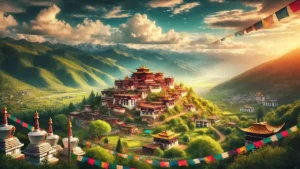Nestled amidst the snow-capped peaks of the majestic Himalayas, Shangri-La Valley is more than just a destination. It is an embodiment of tranquility, mystery, and natural splendor. This hidden paradise captivates the hearts of travelers, adventurers, and dreamers alike. It offers a glimpse into a world where time seems to stand still. The soul finds solace amidst nature’s pristine beauty. The very mention of Shangri-La evokes images of an idyllic retreat. It is a sanctuary of peace and serenity, far removed from the chaotic pulse of the modern world.
The allure of Shangri-La Valley lies not just in its breathtaking landscapes but also in its rich cultural heritage. It holds deep spiritual significance as well. This is a place where myths and legends come alive. Here, ancient traditions blend seamlessly with the rhythms of nature. For those seeking an escape from the mundane, a journey to Shangri-La Valley promises more than just a physical adventure. It offers a voyage into the depths of one’s own spirit.
In this comprehensive guide, we will take you on an enchanting journey through the many facets of Shangri-La Valley. From its mythical origins to its real-world wonders, we will explore everything. We will delve into its history, culture, biodiversity, and conservation efforts. This mystical land is a true treasure trove for explorers and nature enthusiasts alike.
Understanding the Concept of Shangri-La:
Origins of the Shangri-La Myth
The concept of Shangri-La originates from the collective imagination of the West. It was brought to life through James Hilton’s 1933 novel, *Lost Horizon*. In the novel, Hilton describes a hidden paradise nestled in the remote mountains of Tibet. Here, the inhabitants live in peace and harmony, enjoying both longevity and enlightenment. The fictional Shangri-La symbolizes an unspoiled, idyllic place. It is untouched by time and the challenges of the outside world.
Also Read: Swachh Bharat Abhiyan: India’s Monumental Success in Achieving Cleanliness
The myth of Shangri-La is believed to be inspired by real-world locations and legends. These come from Tibetan and Himalayan folklore. Ancient texts and oral traditions speak of a hidden land known as Shambhala. It is a mystical kingdom where peace, prosperity, and enlightenment reign. Shambhala is often depicted as a place of immense beauty and spiritual wisdom. It is accessible only to those who are pure of heart and mind.
Over time, the myth of Shangri-La has evolved beyond its literary origins. It has become a metaphor for any place of refuge or a state of mind that embodies peace and contentment. This timeless allure continues to attract adventurers and seekers of truth. They venture to the far reaches of the Himalayas in search of their own version of Shangri-La.
Shangri-La Valley as a Real-World Destination
While the exact location of the fictional Shangri-La remains a mystery, there are several real-world places that have claimed to be the inspiration for Hilton’s paradise. One such place is the town of Zhongdian in Yunnan Province, China, which was officially renamed Shangri-La in 2001. This region, with its stunning landscapes, diverse ethnic cultures, and rich biodiversity, offers a tantalizing glimpse into what the real Shangri-La might look like.
The town of Shangri-La serves as a gateway to some of the most breathtaking natural wonders in the world. Surrounded by snow-capped peaks, lush valleys, and pristine lakes, it is a haven for trekkers, photographers, and spiritual seekers. The region is also home to the Songzanlin Monastery, the largest Tibetan Buddhist monastery in Yunnan, which stands as a testament to the deep spiritual traditions that permeate the valley.
For those who venture into the heart of Shangri-La Valley, the experience is nothing short of transformative. The crisp mountain air, the vibrant prayer flags fluttering in the breeze, and the serene beauty of the landscapes all combine to create an atmosphere of profound peace and reflection. It is no wonder that Shangri-La Valley is often referred to as the “last paradise on Earth.”
The Mystical Allure of Shangri-La Valley:
What Makes Shangri-La Valley Mysterious?
The mystery of Shangri-La Valley is woven into the very fabric of its landscapes, culture, and history. Unlike many destinations that reveal themselves readily to the visitor, Shangri-La Valley guards its secrets jealously, inviting exploration but never fully yielding its mysteries. This sense of the unknown is a key part of its appeal.
One of the most compelling aspects of Shangri-La Valley is its isolation. Tucked away in the remote regions of the Himalayas, the valley has remained relatively untouched by the outside world. Its remote location, combined with its rugged terrain and harsh climate, has made it difficult to access, preserving its pristine beauty and enigmatic aura. Even today, reaching some parts of the valley requires arduous trekking, crossing high mountain passes, and navigating through dense forests and rocky gorges.
Adding to the valley’s mystique are the numerous legends and folklore that have grown around it over the centuries. Local tales speak of hidden temples and ancient wisdom passed down through generations. There are stories of immortality, of lost civilizations, and of mystical beings that guard the valley from those who would seek to exploit its secrets. These legends have been passed down through generations, each retelling adding new layers to the valley’s enigmatic charm.
Spiritual and Cultural Significance
The spiritual significance of Shangri-La Valley cannot be overstated. For centuries, it has been a place of pilgrimage and spiritual retreat for those seeking enlightenment and inner peace. Ancient monasteries dot the valley, with some perched precariously on cliff edges and others nestled in secluded valleys. Each one serves as a sanctuary for contemplation and prayer.
One of the most revered sites in the valley is the Songzanlin Monastery, also known as the “Little Potala Palace.” This stunning structure, with its golden roofs and intricate carvings, is the largest Tibetan Buddhist monastery in Yunnan. It is home to hundreds of monks who dedicate their lives to the study and practice of Buddhism. The sense of tranquility in the monastery often strikes visitors, as chanting sounds and incense aromas create a deeply spiritual atmosphere.
The valley is also home to a number of sacred lakes, which are believed to be the dwelling places of powerful deities. Pilgrims often undertake long and arduous journeys to these lakes, believing that their waters have the power to purify the soul and bring blessings of health, happiness, and prosperity.
Culturally, Shangri-La Valley is a melting pot of different ethnic groups, each with its own unique traditions, languages, and customs. The most prominent of these are the Tibetan, Naxi, and Yi peoples. Their vibrant festivals, music, and dance add to the region’s rich cultural tapestry. The traditional wooden houses are adorned with colorful prayer flags, creating a picturesque view. Lively markets sell handmade crafts and local delicacies, providing a glimpse into a traditional way of life. This lifestyle has remained largely unchanged for centuries, preserving cultural heritage and authenticity.

Geographic Insights: Locating Shangri-La Valley
Locating Shangri-La Valley: Where is it?
The quest to locate Shangri-La Valley is akin to a modern-day treasure hunt. The valley is often described as lying at the intersection of Tibet, Yunnan, and Sichuan provinces in China, nestled in the eastern part of the Tibetan Plateau. The geographical coordinates of this mythical place, however, are as elusive as the paradise it represents.
The Chinese government has identified the official Shangri-La County, previously known as Zhongdian, as the real-world equivalent of Hilton’s fictional Shangri-La. Situated in the northwest of Yunnan Province, this area features snow-capped mountains, verdant forests, and crystal-clear rivers. decision to rename the town was part of a larger effort to promote tourism and cultural heritage in the region.
Despite this official designation, many argue that the true Shangri-La could be found in other, equally remote and beautiful locations in the Himalayas. Some suggest it may lie in the hidden valleys of Bhutan, others in the high-altitude deserts of Ladakh, or even in the isolated regions of eastern Tibet. Each of these places possesses the qualities described in Lost Horizon: isolation, natural beauty, and a sense of timelessness.
For travelers seeking the “real” Shangri-La, the journey is as much about personal discovery as it is about reaching a physical destination. The landscapes, the people, and the experiences encountered along the way all contribute to the creation of one’s own version of Shangri-La—a place where the boundaries between reality and imagination blur, and the spirit finds peace.
Environmental Significance and Ecosystem Diversity
The environmental significance of Shangri-La Valley is profound. The valley is part of the Three Parallel Rivers of Yunnan Protected Areas. This is a UNESCO World Heritage Site that includes the basins of the Yangtze, Mekong, and Salween rivers. The region is one of the richest areas of biodiversity in the world. It is home to a remarkable variety of ecosystems, ranging from temperate forests and alpine meadows to glacial landscapes and subtropical zones.
Shangri-La Valley’s unique geographical location is at the intersection of several major biogeographical regions. This has given rise to an incredible diversity of plant and animal species. It is home to over 6,000 plant species, including many rare and endemic varieties such as the Yunnan Cypress and the Himalayan Blue Poppy. The forests are dominated by majestic rhododendrons, some growing as tall as trees. In spring, they burst into bloom, displaying a riot of colors.
The valley also serves as a refuge for many endangered animals, including the Snow Leopard, the Black Snub-Nosed Monkey, and the Red Panda. High-altitude meadows and forests provide critical habitats for these species. They are under threat from habitat loss and poaching in other areas. Their presence in Shangri-La Valley is a testament to the region’s ecological richness and resilience. Protecting these species is crucial to maintaining the health and balance of the valley’s ecosystems.
Impact of Geography on Myths and Realities of the Valley
The rugged and dramatic geography of Shangri-La Valley has played a significant role in shaping both the myths and realities of this mystical place. The high mountain ranges, deep gorges, and remote valleys create a sense of isolation and inaccessibility, which has fueled the legends of a hidden paradise, protected from the outside world by natural barriers.
The valley’s stunning landscapes, featuring towering peaks, cascading waterfalls, and tranquil lakes, inspire awe and wonder, often described as otherworldly. People easily imagine this place as a gateway to a mystical realm, where nature’s ordinary laws don’t apply, and peace and harmony reign supreme.
In reality, the harsh terrain and extreme weather conditions make life in Shangri-La Valley challenging. The high altitudes can cause altitude sickness in visitors, and the remote location means that access to modern amenities is limited. Despite these challenges, the people who live in the valley have adapted to their environment, developing a way of life that is in harmony with the land and its rhythms.
The geography of Shangri-La Valley has also influenced the development of its cultural and spiritual traditions. The region’s isolation has preserved ancient beliefs and practices closely tied to the natural world. People see mountains, rivers, and lakes as sacred and often center their customs around worshipping and venerating these natural elements.
Biodiversity and Conservation Efforts:
Endangered Species in Shangri-La Valley
Shangri-La Valley is a biodiversity hotspot, home to a wide variety of plant and animal species, many of which are found nowhere else on Earth. The region’s unique ecosystems, ranging from alpine meadows to dense forests, provide critical habitat for some of the world’s most endangered species.
One of the most iconic residents of the valley is the Snow Leopard, a majestic predator that roams the high-altitude regions of the Himalayas. These elusive cats are known for their solitary nature and their ability to navigate the steep, rocky terrain of their mountainous home. Despite their incredible adaptability, Snow Leopards are under severe threat from habitat loss, poaching, and human-wildlife conflict. Conservation efforts in Shangri-La Valley are focused on protecting these beautiful creatures and ensuring that they can continue to thrive in their natural habitat.
Another unique species found in the valley is the Black Snub-Nosed Monkey. These primates are easily recognizable by their upturned noses and thick, fluffy fur, which helps them survive in the cold, mountainous environment. They are critically endangered, with only a few thousand individuals remaining in the wild. Habitat loss due to logging and agriculture is the primary threat to their survival, and conservation programs in the region are working to protect their forest habitats and raise awareness about their plight.
The Takin, often referred to as a “goat-antelope,” is another rare species that inhabits the valley. With its sturdy build and distinctive horns, the Takin is well-adapted to life in the rugged, mountainous terrain. These animals play an important role in the local ecosystem, and their presence is a sign of the health and vitality of the valley’s natural environment.
Conservation Initiatives and Challenges
Conservationists in Shangri-La Valley actively work to preserve the region’s unique biodiversity and protect its fragile ecosystems from human pressures. They implement various initiatives to tackle challenges facing the valley, such as habitat destruction, climate change, poaching, and unsustainable tourism practices.
One of the key conservation strategies in the region is the establishment of protected areas and wildlife reserves. These areas provide safe havens for endangered species and help to safeguard critical habitats from development and exploitation. The Three Parallel Rivers of Yunnan Protected Areas, a UNESCO World Heritage Site, is one such example. It encompasses several national parks and nature reserves, providing a network of protected landscapes that support a wide range of biodiversity.
Local communities play a crucial role in conservation efforts, as they are often the first line of defense against threats to the environment. Community-based conservation programs involve local people in the management and protection of natural resources, promoting sustainable practices and creating alternative livelihoods that reduce pressure on the land and its wildlife.
Despite these efforts, significant challenges remain. Illegal logging, mining, and infrastructure development continue to pose threats to the valley’s ecosystems. Climate change is also having a profound impact, altering weather patterns and affecting the availability of water and other resources. Addressing these issues requires a coordinated and collaborative approach, involving governments, NGOs, local communities, and the international community.
Importance of Preserving the Unique Wildlife of the Valley
The wildlife of Shangri-La Valley is not just a biological treasure; it is an integral part of the valley’s cultural and spiritual heritage. The animals and plants that inhabit this region have evolved over millennia to adapt to its unique conditions, and they play vital roles in maintaining the health and balance of the ecosystem.
Preserving the wildlife of Shangri-La Valley is essential for several reasons. First, it helps to maintain the biodiversity of the region, which is crucial for the resilience and stability of ecosystems. Each species, no matter how small, has a role to play in the complex web of life, and the loss of any one species can have cascading effects on the entire ecosystem.
Second, the presence of these species is a testament to the valley’s ecological health. Healthy populations of endangered animals like the Snow Leopard and the Black Snub-Nosed Monkey indicate that the ecosystems they inhabit are functioning well and that conservation efforts are having a positive impact.
Finally, preserving the unique wildlife of Shangri-La Valley is a way of honoring the cultural and spiritual values of the people who live there. Many of the species that inhabit the valley are considered sacred or symbolic, and their protection is seen as a moral and ethical responsibility.
Real-Life Residents of Shangri-La Valley:

The Unique Wildlife of Shangri-La Valley
The wildlife of Shangri-La Valley is as diverse and enchanting as the landscapes they inhabit. Each species is a testament to the valley’s rich biodiversity and the resilience of life in one of the world’s most challenging environments.
The Black Snub-Nosed Monkey, with its distinctive upturned nose and thick, shaggy coat, is one of the most unique and endangered primates in the world. These monkeys live in family groups, often high in the treetops, where they feed on leaves, fruits, and other vegetation. They are highly social animals, with complex behaviors and vocalizations that are still not fully understood by scientists. Their presence in the valley is a reminder of the fragility and beauty of the natural world.
The Snow Leopard, often called the “ghost of the mountains,” is another iconic resident of Shangri-La Valley. These elusive predators are known for their ability to navigate the steep, rocky terrain of the high Himalayas, and their stunningly beautiful, thick fur provides camouflage and protection from the cold. Despite their fearsome reputation, Snow Leopards are shy and solitary animals, rarely seen by humans. Their survival is threatened by poaching, habitat loss, and conflict with herders, who sometimes kill them to protect their livestock.
The Takin, known for its stocky build and unusual appearance, symbolizes the valley’s rugged beauty and resilience. These large herbivores thrive in the mountainous terrain, using their strong legs and thick coat to withstand the cold. Often grazing on the steep slopes and alpine meadows, they enrich the tapestry of life in this remote and beautiful region.
Sacred Significance and Conservation Efforts for the Residents
The wildlife of Shangri-La Valley is not only important from a biological perspective but also holds deep cultural and spiritual significance for the people who live there. Many of the animals and plants in the valley are considered sacred, and their protection is seen as a moral and ethical duty.
The Black Snub-Nosed Monkey, for example, is revered in local folklore as a symbol of good fortune and protection. It is believed that harming these animals will bring misfortune. Numerous stories tell of people punished by spirits for violating this taboo. Similarly, the Snow Leopard is seen as a guardian of the mountains. It is a powerful and mysterious being that commands both respect and reverence.
Conservation efforts in the valley often rely on cultural beliefs. These beliefs help promote the protection of wildlife and habitats. Education programs inform local communities about the value of biodiversity. They highlight the role of different species in the ecosystem. Community-based initiatives support sustainable land-use practices. These practices benefit both people and nature, fostering harmony in the valley.
In recent years, eco-tourism has also become an important tool for conservation in Shangri-La Valley. By promoting responsible tourism that respects the environment and local cultures, conservation organizations generate income for local communities. This approach also raises awareness about the need to protect this unique and fragile landscape.
How Reality meets Fiction in Shangri-La Valley?
For many travelers, a visit to Shangri-La Valley is like stepping into a world where reality and fiction blur. The landscapes, the people, and the wildlife all contribute to an atmosphere that feels almost otherworldly, a place where the boundaries between the physical and the spiritual seem to dissolve.
The valley’s stunning natural beauty, with its towering peaks, crystal-clear lakes, and lush meadows, resembles a dream. It is easy to see how such a place could inspire stories of a hidden paradise. A land where peace and happiness reign supreme. The traditional Tibetan houses with their brightly colored prayer flags fluttering in the wind enhance the atmosphere. They add to the timelessness and serenity that define Shangri-La Valley.
But Shangri-La Valley is not just a place of fantasy; it is also a place of hard realities. The people who live here face many challenges, from harsh weather and difficult terrain to limited access to healthcare and education. Yet they have developed a way of life that is in harmony with their environment, drawing on centuries of knowledge and tradition to survive and thrive in this remote and beautiful land.
In this way, the reality of Shangri-La Valley is even more remarkable than the fiction. It is a testament to the resilience of the human spirit. The enduring power of nature continues to inspire wonder and awe. Whether you come to the valley for adventure or spiritual insight, you will find it here. You can also simply seek a break from the hustle and bustle of modern life. You will leave with a sense of having experienced something truly extraordinary.
Journey Through Time: Historical and Modern Perspectives
Historical Explorations and Discoveries
The history of Shangri-La Valley is as rich and complex as its landscapes. For centuries, it has been a place of pilgrimage and exploration, drawing people from all over the world in search of spiritual enlightenment, adventure, and discovery.
Archaeological evidence suggests that the region has been inhabited for thousands of years, with ancient trade routes connecting it to the rest of Asia. These routes, known as the Tea Horse Road, were once bustling with caravans carrying tea, salt, and other goods between China, Tibet, and beyond. The valley was a vital link in this network, its strategic location making it a crossroads of cultures and ideas.
The arrival of Buddhism in the region brought profound changes to the valley’s cultural and spiritual landscape. Monasteries were established, becoming centers of learning, art, and religion. These institutions played a crucial role in preserving the valley’s rich heritage, their influence felt in every aspect of life, from architecture and art to language and customs.
During the 19th and 20th centuries, Western explorers and missionaries ventured into the region. They brought new ideas and technologies, sharing them with local communities. Their accounts described the valley’s stunning scenery and mysterious inhabitants. These stories captured the imagination of people around the world. This fueled the myth of Shangri-La and attracted more adventurers. Many were drawn to explore its remote valleys and peaks, hoping to discover its secrets.
Evolution of the Valley’s Perception Over Time
The perception of Shangri-La Valley has evolved significantly over time, shifting from a purely mythical utopia to a tangible destination of cultural and ecological significance. People initially viewed it as a mystical place, a hidden paradise where peace and harmony reigned. Western literature and romanticized accounts from early explorers largely influenced this perception.
As more people began to visit the region, however, a more nuanced understanding of the valley emerged. Visitors discovered that while the valley was indeed a place of stunning natural beauty and rich cultural heritage, it was also a place where people faced real challenges, from poverty and isolation to environmental degradation and cultural change.
Today, Shangri-La Valley is recognized as a symbol of peace and beauty. It is also a living, breathing community with a complex history and a dynamic present. Efforts to promote sustainable development and conservation are underway. These efforts ensure that the valley’s natural and cultural treasures are preserved for future generations. They also aim to improve the quality of life for the people who call it home.
Modern-Day Experiences and Insights from Travelers
Modern-day travelers to **Shangri-La Valley** are often captivated by its natural beauty, cultural richness, and spiritual depth. Whether trekking through mountains, visiting ancient monasteries, or simply enjoying breathtaking views, they find a sense of peace. The serenity that pervades the valley leaves a lasting impression on every visitor.
For many, visiting **Shangri-La Valley** is an opportunity to disconnect from the stresses of modern life. It’s a chance to reconnect with nature and themselves. The clean mountain air and stunning landscapes provide a refreshing escape. The warm hospitality of the local people adds to the sense of being in a truly special place.
Travelers can learn about the region’s unique cultures and traditions. From vibrant festivals and dances of the Tibetan and Naxi people to intricate handicrafts, the experiences are diverse. The delicious local cuisine also offers a glimpse into the valley’s rich heritage. These encounters provide insights that go beyond the typical tourist experience.
For those willing to explore further, **Shangri-La Valley** holds many hidden gems. Secluded monasteries, hidden lakes, and remote villages reveal a way of life untouched by time. Each discovery deepens the sense of wonder and awe felt by visitors. This remarkable place has a story that continues to unfold with every visit.
The Timeless Allure of Shangri-La Valley
Shangri-La Valley remains a place of mystery and beauty. It captivates the hearts and minds of all who visit. With its rich cultural heritage, stunning landscapes, and unique biodiversity, it’s a treasure trove for explorers. Adventurers and nature lovers alike find endless fascination in this enchanting destination.
From its mythical origins to its modern significance as a haven for endangered species, Shangri-La Valley is extraordinary. It is a place where reality and fantasy meet in stunning harmony. The commitment to preserving its unique wildlife and cultural traditions is remarkable. This dedication ensures the land’s sacred nature is honored, safeguarding its wonders for future generations.
Also Read: Festivals in India and Beyond: Celebrations, Significance, and Unity
As we explore and appreciate the diverse facets of Shangri-La Valley, its importance becomes clear. Preserving and protecting the valley’s natural and cultural treasures is crucial. Whether you are an adventurer, dreamer, or someone seeking peace, Shangri-La Valley offers an unforgettable journey. It is a land where myths meet reality, and dreams take flight.
Let us celebrate and protect the beauty and magic of Shangri-La Valley. Embrace both its past glory and future promise with reverence and awe. By doing so, we ensure this timeless paradise remains a beacon of hope. It will inspire all who seek its tranquil embrace.









